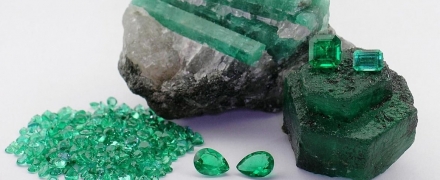open 10 am - 7 pm
laboratory is closed
The origin of emerald in nature.

Everyone knows a green gem - an emerald, but few thought about how it is formed. So, let's figure it out together on this issue.
Currently, all emerald deposits are divided into three categories: pegmatite, greisen and telethermal. In the deposits of the first two groups, the formation of emeralds occurs from beryllium-containing solutions, which are part of granite magma. These solutions interact with ultrabasic rocks with the subsequent removal of chromium from them. And chrome, as you know, is the cause of the green color of emeralds. The pegmatite deposits of emerald are insignificant. They are known in the USA (Old Plantation) and Norway (Aidswell). Emerald crystals in such deposits are found in myarols (cavities) of pegmatites along with other precious stones. But there is one necessary condition, compliance with which is necessary for the formation of emeralds - pegmatite bodies must cross only ultrabasic rocks, otherwise pale beryls will form instead of emerald.
Greisen emerald deposits are represented by micaceous rocks, which occur in metamorphosed ultrabasic rocks together with plagioclase bodies and quartz veins. Emerald crystals in this type of deposits are always localized precisely in mica rocks. Regarding the formation of emerald-bearing mica, there are many hypotheses, most of which hold the opinion of several stages of their formation, differing in different composition of mineralization and temperature of formation. It is believed that emeralds formed in the last of these stages, as evidenced by the inclusion of phlogopite in samples from deposits of this type. The emerald mines of the Urals are a clear example of graysen deposits.
The third category of deposits, telethermal, is represented by Colombian deposits. Most scientists associate the formation of emeralds here with pneumatic-hydrothermal activity of magmatic formations, that is, under the influence of high-temperature solutions on the host rocks.
В геммологической практике бывают весьма увлекательные случаи с диагностикой ювелирных вставок
Но помимо редкости цвета и высокой стоимости таких камней, многие розовые камни выделяются одной замечательной особенностью – они проявляют плеохроизм, то есть в зависимости от положения осмотра камня он может иметь дополнительные оттенки – оранжевый или пурпурный.
Currently, gemstones are produced by two fundamentally different technological methods - the High Pressure - High Temperature method (“HPHT”, High-pressure & High-temperature) and the Chemical Vapor Deposition (“CVD”, Chemical vapor deposition) method. The "HPHT" method is the most tested classical synthesis method, which can be used both carbon deposition on diamond from flux melts and catalytic reactions. In "CVD" synthesis, diamond growth occurs on a seed during carbon deposition mainly from a gaseous medium at relatively low temperatures and pressures.
Jewelry and precious stones are just such a category of goods, when buying which you need to pay attention to many criteria.
Sogdianite is a rather rare mineral and more often it can be found as a collection material (moreover, in systematic collections), and it is extremely rare in jewelry.






